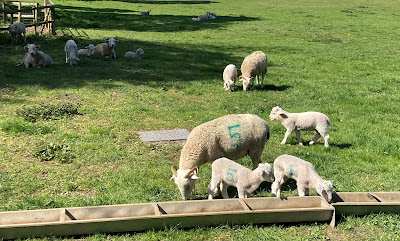I post about day-to-day happenings and reflections in our smallholding life. Sometimes I include observations that are a source of personal delight, such as spotting a native plant coming into flower. Or perhaps the successful germination of some seeds that have been sown. Sometimes the birth of lambs or the hatching of chicks. Part of me feels this is all rather trivial (even insensitive) in the context of a pandemic that has ravaged many people's lives; or the outrageousness of Putin's invasion of Ukraine; or the current on-going genocide in Myanmar (and many other forgotten wars around the world - remember the Rohingya?); and closer to home, the routine presence of food banks in virtually every town and community. Then, encompassing all, there is the impact of global heating, the effects of which are already impoverishing further many parts of the world and with worse to come. And much more.
But then this is a blog with a theme in which I share and sometimes reflect upon theme-related experiences. Some of it is simple descriptions of events (good and bad) and sometimes attempts at sharing delights. If the theme of the blog was something else then I would hope I would do the same with different observations and alternative delights.
Even so...
However, I recently came across a poet (the American poet Jack Gilbert, 1925-1912), who I was not familiar with, and one of his poem's which provides a defence for the experience of delight and why joy is not only justifiable but also important "despite everything".
A Brief for the Defense
Sorrow everywhere. Slaughter everywhere. If babies
are not starving someplace, they are starving
somewhere else. With flies in their nostrils.
But we enjoy our lives because that’s what God wants.
Otherwise the mornings before summer dawn would not
be made so fine. The Bengal tiger would not
be fashioned so miraculously well. The poor women
at the fountain are laughing together between
the suffering they have known and the awfulness
in their future, smiling and laughing while somebody
in the village is very sick. There is laughter
every day in the terrible streets of Calcutta,
and the women laugh in the cages of Bombay.
If we deny our happiness, resist our satisfaction,
we lessen the importance of their deprivation.
We must risk delight. We can do without pleasure,
but not delight. Not enjoyment. We must have
the stubbornness to accept our gladness in the ruthless
furnace of this world. To make injustice the only
measure of our attention is to praise the Devil.
If the locomotive of the Lord runs us down,
we should give thanks that the end had magnitude.
We must admit there will be music despite everything.
We stand at the prow again of a small ship
anchored late at night in the tiny port
looking over to the sleeping island: the waterfront
is three shuttered cafés and one naked light burning.
To hear the faint sound of oars in the silence as a rowboat
comes slowly out and then goes back is truly worth
all the years of sorrow that are to come.
by Jack Gilbert
What is Jack Gilbert's case for the defence of delight? Firstly, God ordains it ("that's what God wants"). Among the many scriptural exhortations to be joyful is "This is the day the Lord has made, rejoice and be glad". Secondly, the beauty to be found in the world ("summer dawn", the "Bengal tiger"). Thirdly, the capacity for shared laughter in the midst of life's deprivations ("The poor women at the fountain are laughing together between the suffering they have known and the awfulness in their future"). Fourthly, in resisting delight it somehow undermines our sorrows and those of others ("If we deny our happiness, resist our satisfaction, we lessen the importance of their deprivation").
Therefore, "in the ruthless furnace of the world" we must nevertheless "admit there will be music despite everything". "We must risk delight. We can do without pleasure, but not delight".
Any delights that emanate from a smallholding life are not the sum total of my emotional life of course and, like everyone else, life includes sources of disappointment and sorrow. But at the same time the sources of sorrow do not account for the totality of life experiences. I think I'll continue to share the trivial, delightful or otherwise.
 |
| ...And speaking of which, yesterday I found a cowslip flowering in some rough grass. The first time I have seen one on our holding. Once so profusely abundant, now becoming more common again. |




















